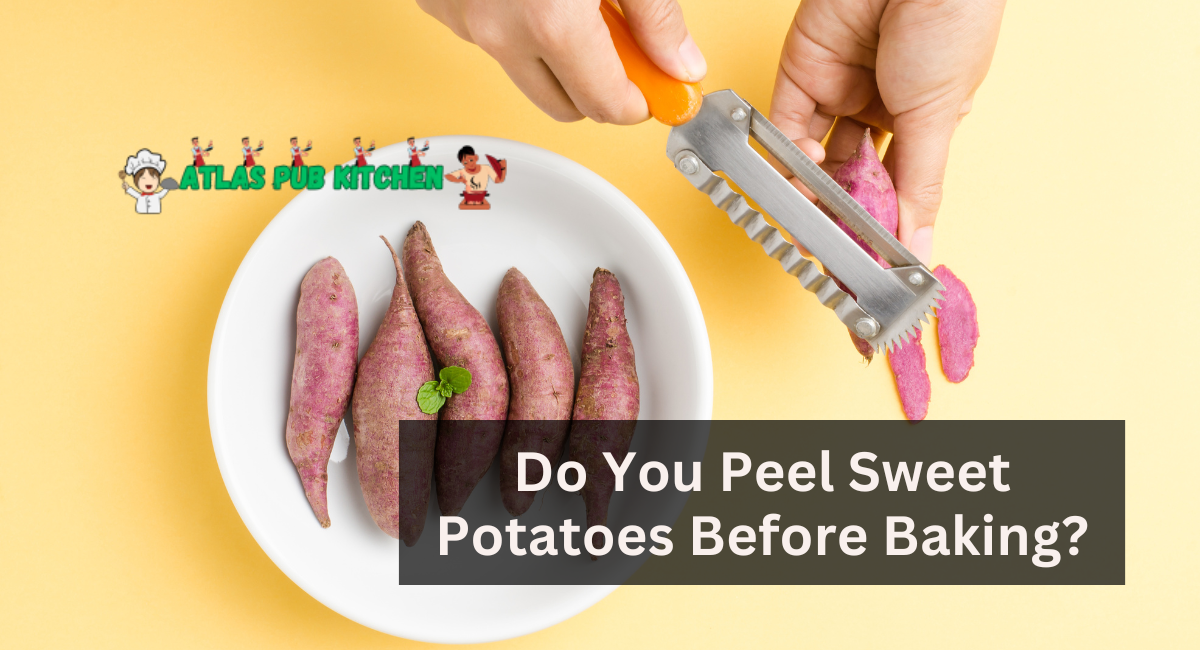With their vibrant hue and natural flavor, sweet potatoes are a popular and nutritious ingredient in various dishes. As a versatile vegetable, sweet potatoes can be cooked in multiple methods, including baking. This article explores the factors and ramifications of peeling sweet potatoes before roasting.
Do You Peel Sweet Potatoes Before Baking?
1. Peel Sweet Potatoes Before Baking.
With their vibrant orange coloration and sweet flavor, sweet potatoes are well-liked due to their versatility in the kitchen. A typical culinary conundrum arises when preparing sweet potatoes: should the sweet potatoes be peeled before baking, or should the skin be left on? This choice can considerably affect the final dish’s flavor, texture, appearance, and nutritional value.
2. Motives For Peeling
One of the primary motivations for peeling sweet potatoes before baking is to obtain a softer and creamier texture. The sweet potatoes cook more evenly and incorporate flavors and seasonings better when the skin is removed, resulting in a smoother texture.
Peeled sweet potatoes provide a more uniform and aesthetically appealing appearance, particularly when desired smoother texture, such as in mashed sweet potatoes or sweet potato pies.
Some individuals merely prefer the flavor and texture of sweet potatoes without the skin, as they find the taste milder and more consistent.
3. Reasons To Avoid Peeling:
The epidermis of sweet potatoes is an excellent source of fiber, vitamins, minerals, and antioxidants. Keeping the skin on preserves these vital nutrients, enhancing the dish’s nutritional value.
The slightly earthy and bitter flavor of the skin of sweet potatoes can add complexity and dimension to the dish’s overall flavor. It can enhance the inherent sweetness of the tissue.
Baking sweet potatoes with the skin on them is more convenient and reduces meal preparation time. The skin functions as a natural barrier, helping retain moisture and preventing sweet potatoes from becoming mushy during baking.
How Do You Peel Sweet Potatoes In Preparation For Baking?
Only a few basic steps are involved in peeling sweet potatoes for baked sweet potatoes. Here are the steps for skinning sweet potatoes:
- The Trimming Process: Both extremities of each sweet potato should have a thin slice removed. This establishes a stable foundation for flaking.
- Safeguard Sweet Potatoes: Place the sweet potato on a cutting board while ensuring it is stable and will not shift.
- Start by peeling: Hold the sweet potato solidly with one hand and the vegetable peeler firmly with the other. Beginning at the top of the sweet potato, position the peeler and delicately glide it down the length of the potato in a downward motion to remove the skin. Ensure uniform skin removal by rotating the sweet potato as you peel.
- Remove any residual stains: Use a knife to remove any remaining spots or imperfections meticulously.
- Don’t Wet: The sweet potatoes should be dried with a clean kitchen towel or paper towel.
How Long Before Cooking Can Sweet Potatoes Be Peeled?
You can peel sweet potatoes beforehand, but it’s best to do so when you intend to cook or use them. Ideally, sweet potatoes should be peeled just before preparing or within a few hours to preserve their freshness and prevent discoloration.
If you need to prepare sweet potatoes ahead of time due to a demanding schedule or to save time while preparing meals, consider the following:
Brief Storage (A Few Hours): If you must peel sweet potatoes several hours before cooking, place them in cold water to prevent browning and preserve their freshness. Drain and pat dry before heating.
Store Correctly: If you must peel sweet potatoes beforehand, refrigerate them in an opaque container. Ensure that they are submerged in water to avoid discoloration.
Ideally, peel just before cooking: When practicable, peel sweet potatoes immediately before cooking to preserve their flavor, texture, and nutritional value.
Observing the sweet potatoes for signs of deterioration, such as color changes and off aromas, is essential. If you follow any of these signs, you should avoid them.
What Is The Most Efficient Method Of Peeling Sweet Potatoes?
The quickest method for peeling sweet potatoes involves maximizing efficacy and minimizing time. Here is a step-by-step guide on how to skin sweet potatoes as quickly as possible:
- Collect Your Supplies: The sweet potato, Vegetable peeling device, and chopping block.
- Cut the Fat: Cut a thin sliver off both ends of each sweet potato. This provides a solid foundation for stripping.
- Slicing Sweet Potatoes: Cut the sweet potatoes into manageable, approximately 2-inch-long sections. This will facilitate their handling during the flaking process.
- Position for Optimal Peeling: Hold one of the sweet potato sections with one hand, ensuring a secure hold.
- Commence Peeling: With the vegetable peeler, on the other hand, skin the sweet potato from the top to the bottom, following its shape. Peel the epidermis using a gentle, controlled motion, rotating the sweet potato as necessary.
- Repeat the Method: Repeat the peeling procedure for each sweet potato section.
- Rinse and Clean: Under flowing water, rinse the peeled sweet potato sections to remove any remaining skin or debris.
- Pa t Dryness: Dab the sweet potato sections dry using a clean kitchen towel or paper towel.
Whether or not to skin sweet potatoes before baking is a matter of personal preference and desired outcome; when sweet potatoes are peeled before roasting, their texture becomes softer and smoother, making them ideal for mashing or pureeing. In contrast, leaving the skin on provides a slightly firmer texture and improves the dish’s overall appearance. Additionally, the epidermis contains beneficial nutrients and fiber. The decision ultimately depends on your culinary objectives and flavor preferences. Whether peeled or unpeeled, baked sweet potatoes are a flavorful and nutritious addition to your meals.
Thanks for reading.










